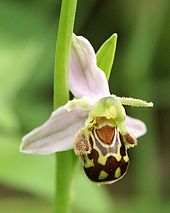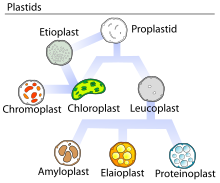Chromoplast

Chromoplasts are
Function
Chromoplasts are found in
They are generally found in mature tissues and are derived from preexisting mature plastids. Fruits and flowers are the most common structures for the biosynthesis of carotenoids, although other reactions occur there as well including the synthesis of sugars, starches, lipids, aromatic compounds, vitamins, and hormones.
Chromoplasts synthesize and store pigments such as orange
When
There are some species of flowering plants that contain little to no carotenoids. In such cases, there are plastids present within the petals that closely resemble chromoplasts and are sometimes visually indistinguishable.
The term "chromoplast" is occasionally used to include any plastid that has pigment, mostly to emphasize the difference between them and the various types of leucoplasts, plastids that have no pigments. In this sense, chloroplasts are a specific type of chromoplast. Still, "chromoplast" is more often used to denote plastids with pigments other than chlorophyll.
Structure and classification
Using a
The presence, frequency and identification of substructures using an electron microscope has led to further classification, dividing chromoplasts into five main categories: Globular chromoplasts, crystalline chromoplasts, fibrillar chromoplasts, tubular chromoplasts and membranous chromoplasts.
Although some chromoplasts are easily categorized, others have characteristics from multiple categories that make them hard to place. Tomatoes accumulate carotenoids, mainly lycopene crystalloids in membrane-shaped structures, which could place them in either the crystalline or membranous category.[3]
Evolution
Research
Chromoplasts are not widely studied and are rarely the main focus of scientific research. They often play a role in research on the tomato plant (
Carotenoid biosynthesis occurs in both chromoplasts and
White flowers are caused by a recessive allele in tomato plants. They are less desirable in cultivated crops because they have a lower pollination rate. In one study, it was found that chromoplasts are still present in white flowers. The lack of yellow pigment in their petals and anthers is due to a mutation in the CrtR-b2 gene which disrupts the carotenoid biosynthesis pathway.[6]
The entire process of chromoplast formation is not yet completely understood on the molecular level. However, electron microscopy has revealed part of the transformation from chloroplast to chromoplast. The transformation starts with remodeling of the internal membrane system with the
In oranges, the synthesis of carotenoids and the disappearance of chlorophyll causes the color of the fruit to change from green to yellow. The orange color is often added artificially—light yellow-orange is the natural color created by the actual chromoplasts.[7]
Valencia oranges
Compare plastids

- Plastid
- Chloroplast and etioplast
- Chromoplast
- Lycopene: red color of tomato
- Capasanthin: red color of peppers
- β-Carotene: red color of carrot
- Xanthophyll: yellow coloration
- Anthocyanin: purple, red, blue, or black coloration
- Leucoplast
- Amyloplast
- Elaioplast
- Proteinoplast (aleuroplast)
